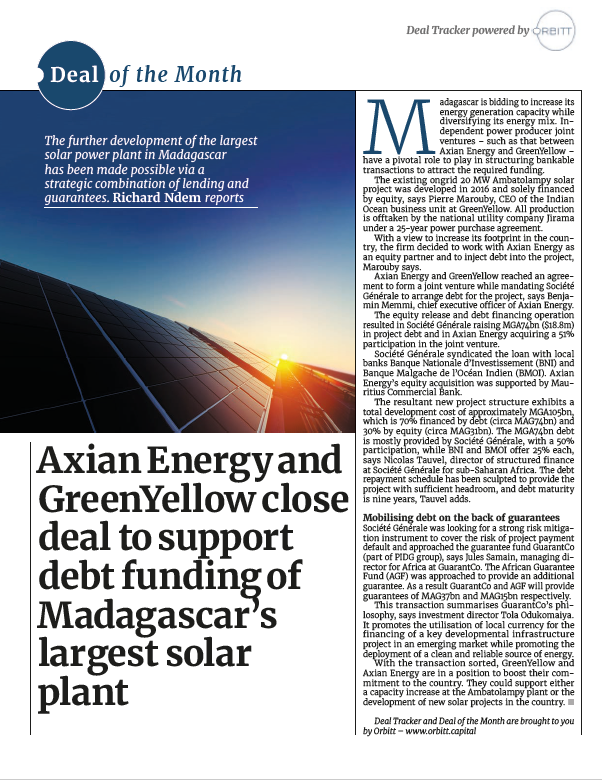 In association with African Business Magazine, market leaders in providing country supplements, industry reports and market intelligence on Africa.
In association with African Business Magazine, market leaders in providing country supplements, industry reports and market intelligence on Africa.
Find out more +
Madagascar is bidding to increase its energy generation capacity while diversifying its energy mix. Independent power producer joint ventures – such as that between Axian Energy and GreenYellow have a pivotal role to play in structuring bankable transactions to attract the required funding.
The existing ongrid 20 MW Ambatolampy solar project was developed in 2016 and solely financed by equity, says Pierre Marouby, CEO of the Indian Ocean business unit at GreenYellow. All production is off taken by the national utility company Jirama under a 25-year power purchase agreement. With a view to increase its footprint in the country, the firm decided to work with Axian Energy as an equity partner and to inject debt into the project, Marouby says. Axian Energy and GreenYellow reached an agreement to form a joint venture while mandating Société Générale to arrange debt for the project, says Benjamin Memmi, chief executive offi cer of Axian Energy.
The equity release and debt financing operation resulted in Société Générale raising MGA74bn ($18.8m) in project debt and in Axian Energy acquiring a 51% participation in the joint venture. Société Générale syndicated the loan with local banks Banque Nationale d’Investissement (BNI) and Banque Malgache de l’Océan Indien (BMOI). Axian Energy’s equity acquisition was supported by Mauritius Commercial Bank.
The resultant new project structure exhibits a total development cost of approximately MGA105bn, which is 70% fi nanced by debt (circa MAG74bn) and 30% by equity (circa MAG31bn). The MGA74bn debt is mostly provided by Société Générale, with a 50% participation, while BNI and BMOI off er 25% each, says Nicolas Tauvel, director of structured finance at Société Générale for sub-Saharan Africa. The debt repayment schedule has been sculpted to provide the project with suffi cient headroom, and debt maturity is nine years, Tauvel adds.
Mobilising debt on the back of guarantees
Société Générale was looking for a strong risk mitigation instrument to cover the risk of project payment default and approached the guarantee fund GuarantCo (part of PIDG group), says Jules Samain, managing director for Africa at GuarantCo. The African Guarantee Fund (AGF) was approached to provide an additional guarantee. As a result, GuarantCo and AGF will provide guarantees of MAG37bn and MAG15bn respectively. This transaction summarises GuarantCo’s philosophy, says investment director Tola Odukomaiya.
It promotes the utilisation of local currency for the financing of a key developmental infrastructure project in an emerging market while promoting the deployment of a clean and reliable source of energy. With the transaction sorted, GreenYellow and Axian Energy are in a position to boost their commitment to the country. They could support either a capacity increase at the Ambatolampy plant or the development of new solar projects in the country.
Madagascar is bidding to increase its energy generation capacity while diversifying its energy mix. Independent power producer joint ventures – such as that between Axian Energy and GreenYellow have a pivotal role to play in structuring bankable transactions to attract the required funding.
The existing ongrid 20 MW Ambatolampy solar project was developed in 2016 and solely financed by equity, says Pierre Marouby, CEO of the Indian Ocean business unit at GreenYellow. All production is off taken by the national utility company Jirama under a 25-year power purchase agreement. With a view to increase its footprint in the country, the firm decided to work with Axian Energy as an equity partner and to inject debt into the project, Marouby says. Axian Energy and GreenYellow reached an agreement to form a joint venture while mandating Société Générale to arrange debt for the project, says Benjamin Memmi, chief executive offi cer of Axian Energy.
The equity release and debt financing operation resulted in Société Générale raising MGA74bn ($18.8m) in project debt and in Axian Energy acquiring a 51% participation in the joint venture. Société Générale syndicated the loan with local banks Banque Nationale d’Investissement (BNI) and Banque Malgache de l’Océan Indien (BMOI). Axian Energy’s equity acquisition was supported by Mauritius Commercial Bank.
The resultant new project structure exhibits a total development cost of approximately MGA105bn, which is 70% fi nanced by debt (circa MAG74bn) and 30% by equity (circa MAG31bn). The MGA74bn debt is mostly provided by Société Générale, with a 50% participation, while BNI and BMOI off er 25% each, says Nicolas Tauvel, director of structured finance at Société Générale for sub-Saharan Africa. The debt repayment schedule has been sculpted to provide the project with suffi cient headroom, and debt maturity is nine years, Tauvel adds.
Mobilising debt on the back of guarantees
Société Générale was looking for a strong risk mitigation instrument to cover the risk of project payment default and approached the guarantee fund GuarantCo (part of PIDG group), says Jules Samain, managing director for Africa at GuarantCo. The African Guarantee Fund (AGF) was approached to provide an additional guarantee. As a result, GuarantCo and AGF will provide guarantees of MAG37bn and MAG15bn respectively. This transaction summarises GuarantCo’s philosophy, says investment director Tola Odukomaiya.
It promotes the utilisation of local currency for the financing of a key developmental infrastructure project in an emerging market while promoting the deployment of a clean and reliable source of energy. With the transaction sorted, GreenYellow and Axian Energy are in a position to boost their commitment to the country. They could support either a capacity increase at the Ambatolampy plant or the development of new solar projects in the country.
Read this Deal of the month, including Deal tracker and more via African Business Magazine



